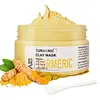What's inside
What's inside
 Key Ingredients
Key Ingredients

 Benefits
Benefits

 Concerns
Concerns

 Ingredients Side-by-side
Ingredients Side-by-side

Water
Skin ConditioningCucurbita Maxima Fruit Extract
Skin ConditioningHelianthus Annuus Seed Oil
EmollientEthylhexyl Palmitate
EmollientCetearyl Alcohol
EmollientGlycerin
HumectantPropanediol
SolventCellulose
AbsorbentCitrus Limon Peel Powder
AbsorbentGlyceryl Stearate
EmollientOryza Sativa Powder
Shea Butter Ethyl Esters
EmollientXylityl Sesquicaprylate
AntimicrobialLactobacillus/Pumpkin Ferment Extract
Skin ConditioningCucurbita Pepo Fruit Extract
Skin ConditioningCucurbita Pepo Seed Oil
EmollientSodium Hyaluronate
HumectantBromelain
Skin ConditioningPapain
Skin ConditioningLactobacillus Ferment
Skin ConditioningGlycolipids
Skin ConditioningTocopherol
AntioxidantAscorbyl Palmitate
AntioxidantDaucus Carota Sativa Root Extract
Skin ConditioningGlycine Soja Oil
EmollientDaucus Carota Sativa Seed Oil
EmollientHydrogenated Corn Oil
Skin ConditioningXanthan Gum
EmulsifyingAcacia Senegal Gum
MaskingSodium Lactate
BufferingCetyl Alcohol
EmollientStearyl Alcohol
EmollientPolyacrylate Crosspolymer-6
Emulsion StabilisingHydroxyethyl Acrylate/Sodium Acryloyldimethyl Taurate Copolymer
Emulsion StabilisingBehenyl Alcohol
EmollientCetearyl Glucoside
EmulsifyingCaprylyl/Capryl Glucoside
CleansingMaltodextrin
AbsorbentSodium Phytate
Tetrasodium Glutamate Diacetate
Phenoxyethanol
PreservativeEthylhexylglycerin
Skin ConditioningCitric Acid
BufferingParfum
MaskingEugenol
PerfumingCI 40800
Cosmetic ColorantCI 14700
Cosmetic ColorantWater, Cucurbita Maxima Fruit Extract, Helianthus Annuus Seed Oil, Ethylhexyl Palmitate, Cetearyl Alcohol, Glycerin, Propanediol, Cellulose, Citrus Limon Peel Powder, Glyceryl Stearate, Oryza Sativa Powder, Shea Butter Ethyl Esters, Xylityl Sesquicaprylate, Lactobacillus/Pumpkin Ferment Extract, Cucurbita Pepo Fruit Extract, Cucurbita Pepo Seed Oil, Sodium Hyaluronate, Bromelain, Papain, Lactobacillus Ferment, Glycolipids, Tocopherol, Ascorbyl Palmitate, Daucus Carota Sativa Root Extract, Glycine Soja Oil, Daucus Carota Sativa Seed Oil, Hydrogenated Corn Oil, Xanthan Gum, Acacia Senegal Gum, Sodium Lactate, Cetyl Alcohol, Stearyl Alcohol, Polyacrylate Crosspolymer-6, Hydroxyethyl Acrylate/Sodium Acryloyldimethyl Taurate Copolymer, Behenyl Alcohol, Cetearyl Glucoside, Caprylyl/Capryl Glucoside, Maltodextrin, Sodium Phytate, Tetrasodium Glutamate Diacetate, Phenoxyethanol, Ethylhexylglycerin, Citric Acid, Parfum, Eugenol, CI 40800, CI 14700
Ingredients Explained
These ingredients are found in both products.
Ingredients higher up in an ingredient list are typically present in a larger amount.
Ethylhexyl Palmitate, also known as octyl palmitate, is created from 2-ethylhexyl alcohol and palmitic acid. It is a fatty acid ester.
The fatty acid content of Ethylhexyl Palmitate makes it an emollient. Emollients help soften and hydrate your skin by trapping moisture within.
Ethylhexyl Palmitate is also used to help improve the texture of cosmetics. It helps other ingredient dissolve in products and help disperse ingredients more evenly.
You'll likely find this ingredient in sunscreen, as it is often used to mix UV-blocking ingredients such as avobenzone and ethylhexyl triazone.
It can also help stabilize the fragrances in a product as a fragrance fixative.
Ethylhexyl Palmitate can be used to substitute mineral oil.
Due to its high fatty acid content, it may not be fungal-acne safe.
Learn more about Ethylhexyl PalmitateGlycerin is already naturally found in your skin. It helps moisturize and protect your skin.
A study from 2016 found glycerin to be more effective as a humectant than AHAs and hyaluronic acid.
As a humectant, it helps the skin stay hydrated by pulling moisture to your skin. The low molecular weight of glycerin allows it to pull moisture into the deeper layers of your skin.
Hydrated skin improves your skin barrier; Your skin barrier helps protect against irritants and bacteria.
Glycerin has also been found to have antimicrobial and antiviral properties. Due to these properties, glycerin is often used in wound and burn treatments.
In cosmetics, glycerin is usually derived from plants such as soybean or palm. However, it can also be sourced from animals, such as tallow or animal fat.
This ingredient is organic, colorless, odorless, and non-toxic.
Glycerin is the name for this ingredient in American English. British English uses Glycerol/Glycerine.
Learn more about GlycerinGlyceryl Stearate is a mix of glycerin and stearic acid.
It is used to stabilize the mixing of water and oil ingredients. By preventing these ingredients from separating, it can help elongate shelf life. It can also help thicken the product's texture.
As an emollient, it helps soften skin and supports barrier-replenishing ingredients.
In cosmetics, Glyceryl Stearate is often made from vegetable oils or synthetically produced.
This ingredient may not be fungal-acne safe
Fun fact: The human body also creates Glyceryl Stearate naturally.
Learn more about Glyceryl StearateWater. It's the most common cosmetic ingredient of all. You'll usually see it at the top of ingredient lists, meaning that it makes up the largest part of the product.
So why is it so popular? Water most often acts as a solvent - this means that it helps dissolve other ingredients into the formulation.
You'll also recognize water as that liquid we all need to stay alive. If you see this, drink a glass of water. Stay hydrated!
Learn more about WaterXanthan gum is used as a stabilizer and thickener within cosmetic products. It helps give products a sticky, thick feeling - preventing them from being too runny.
On the technical side of things, xanthan gum is a polysaccharide - a combination consisting of multiple sugar molecules bonded together.
Xanthan gum is a pretty common and great ingredient. It is a natural, non-toxic, non-irritating ingredient that is also commonly used in food products.
Learn more about Xanthan Gum